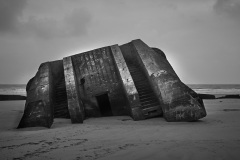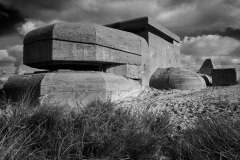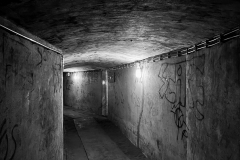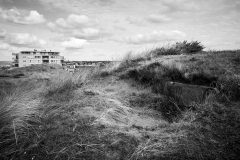The Atlantic Wall (German: Atlantikwall) was an extensive system of coastal defences and fortifications built by Nazi Germany between 1942 and 1944 along the coast of continental Europe and Scandinavia as a defence against an anticipated Allied invasion of Nazi-occupied Europe from the United Kingdom, during World War II. The manning and operation of the Atlantic Wall was administratively overseen by the German Army, with some support from Luftwaffe ground forces. The Kriegsmarine maintained a separate coastal defence network, organised into a number of sea defence zones.

The beach of Wissant, in Nord-Pas-de-Calais in France, is still full of WWII obstacles en bunkers. The sea is slowly pulling them in or digging away the sand from under them so the concrete structures seem to lie scattered all over the beach. Still, you can get a good picture of the thoroughness with which the German defence was prepared. And looking at this coastline, it doesn’t seem strange at all that they expected a landing at Wissant.

The former Atlantic Wall near IJmuiden, The Netherlands.
One of the largest and most important fortifications of the Atlantic Wall was 'Festung IJmuiden'. The entrance of the North Sea Canal was of great strategic importance to the Germans and IJmuiden was very suitable as a harbor for the German navy. The canal gave access to the industry of IJmuiden, the Zaanstreek and Amsterdam, and the lock complex made it possible to regulate the water in a large part of North Holland.
Around IJmuiden, the Germans built a tank barrier of steep dunes, tank walls and tank ditches. Inside were dozens of coastal and anti-aircraft batteries, tank obstacles and bunkers. Fort Island in the middle of the North Sea Canal was extra heavily reinforced. For all those war works, many houses were demolished in Oud-IJmuiden near the harbors and at IJmuiden-Noord. Peaceful IJmuiden turned into a grim war zone.
One of the largest and most important fortifications of the Atlantic Wall was 'Festung IJmuiden'. The entrance of the North Sea Canal was of great strategic importance to the Germans and IJmuiden was very suitable as a harbor for the German navy. The canal gave access to the industry of IJmuiden, the Zaanstreek and Amsterdam, and the lock complex made it possible to regulate the water in a large part of North Holland.
Around IJmuiden, the Germans built a tank barrier of steep dunes, tank walls and tank ditches. Inside were dozens of coastal and anti-aircraft batteries, tank obstacles and bunkers. Fort Island in the middle of the North Sea Canal was extra heavily reinforced. For all those war works, many houses were demolished in Oud-IJmuiden near the harbors and at IJmuiden-Noord. Peaceful IJmuiden turned into a grim war zone.

On the Dutch island Schiermonnikoog a complete blockhouse village was constructed with the purpose of air defense, including radar and listening equipment.
The blockhouse Wassermann has been developed to serve as the basis for a huge radar antenna. Next to that there was capacity for an electricity generator and data translation/interpretation. The radar antenna consisted of a 40 meters tall steel cylinder with mounted antennae. This type of radar carried the name "Wassermann-S(chwer)" [Schwer = heavy]. This enabled the management of approaching airplanes in the airspace within a range of 300 kilometres [over 186 miles]. The steel mast however was never placed.
The blockhouse Wassermann has been developed to serve as the basis for a huge radar antenna. Next to that there was capacity for an electricity generator and data translation/interpretation. The radar antenna consisted of a 40 meters tall steel cylinder with mounted antennae. This type of radar carried the name "Wassermann-S(chwer)" [Schwer = heavy]. This enabled the management of approaching airplanes in the airspace within a range of 300 kilometres [over 186 miles]. The steel mast however was never placed.

This area of dunes near Noordwijk - The Netherlands - caught the eye of the German Navy towards the end of 1940. They stationed here over 180 personnel. For these soldiers accommodation, washrooms and lavatories as well as combat stations had to be installed. Around 80 constructions have been built during the war. The construction of the largest block house, the S414, was composed of 1.800 cubic meters of concrete.

Widerstandsnest 157 – Marine Seezielbatterie ‘Zuidzand’
Just south of Zandvoort, the Zuidzand battery was reported ready for combat around June 1942. The battery then still consists of a number of open gun emplacements, as was the case with many batteries at the beginning of the war. The fire control took place from a Verstärkt Feldmässige Leitstand. During the war, some fifty bunkers were built in the Zuidzand battery. The main armament consisted of four 9.4 cm guns. The bunkers hardly deviated from the standard design and on many German documents the were simply referred to as 671 S.K.
Just south of Zandvoort, the Zuidzand battery was reported ready for combat around June 1942. The battery then still consists of a number of open gun emplacements, as was the case with many batteries at the beginning of the war. The fire control took place from a Verstärkt Feldmässige Leitstand. During the war, some fifty bunkers were built in the Zuidzand battery. The main armament consisted of four 9.4 cm guns. The bunkers hardly deviated from the standard design and on many German documents the were simply referred to as 671 S.K.